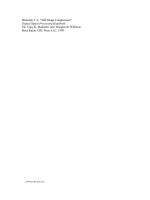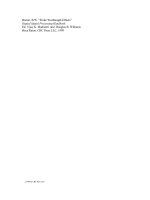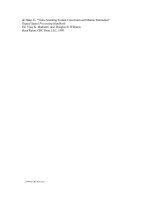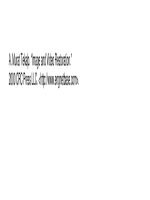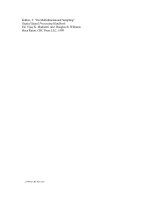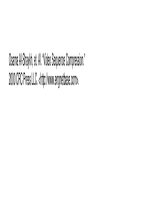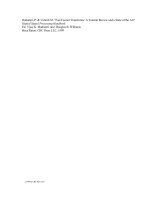Digital Signal Processing Handbook P58
Bạn đang xem bản rút gọn của tài liệu. Xem và tải ngay bản đầy đủ của tài liệu tại đây (127.29 KB, 8 trang )
Reeves, S.J. “A Survey of Image Processing Software and Image Databases”
Digital Signal Processing Handbook
Ed. Vijay K. Madisetti and Douglas B. Williams
Boca Raton: CRC Press LLC, 1999
c
1999byCRCPressLLC
58
A Survey of Image Processing
Software and Image Databases
Stanley J. Reeves
Auburn University
58.1 Image Processing Software
General Image Utilities
•
Specialized Image Utilities
•
Pro-
gramming/Analysis Environments
58.2 Image Databases
Images by Form
Image processing has moved into the mainstream, not only of the engineering world, but of society
in general. Personal computers are now capable of handling large graphics and images with ease,
and fast networks and modems transfer images in a fraction of the time required just a few years
ago. Image manipulation software is a common item on PCs, and CD-ROMs filled with images
and multimedia databases are standard fare in the realm of electronic publishing. Furthermore, the
development of areas such as data compression, neural networks and pattern recognition, computer
vision, and multimedia systems have all contributed to the use of and interest in image processing.
Likewise, the growth of image processing as an engineering discipline has fueled interestinthese other
areas. As a result of this symbiotic growth, image processing has increasingly become a standard tool
in the repertoire of the engineer.
Because of the popularity of image processing, a large array of tools has emerged for accomplishing
various image processing tasks. In addition, a variety of image databases has been created to address
the needs of various specialty areas. In this article, we will survey some of the tools available for
accomplishing basic image processing tasks and indicate where they may be obtained. Furthermore,
wewilldescribeandprovidepointerstosomeofthemost generally usefulimagesandimage databases.
The goal is to identify a basic collection of images and software that will be of use to the nonspecialist.
It should also be of use to the specialist who needs a general tool in an area outside his or her specialty.
58.1 Image Processing Software
Imageprocessinghas become such a broad areathat it is sometimes difficult to distinguish what might
be considered an image processing package from other software systems. The boundaries among
the areas of computer graphics, data visualization, and image processing have become blurred.
Furthermore, to discuss or even to list all the image processing software available would require
many pages and would not be particularly useful to the nonspecialist. Therefore, we emphasize a
representative set of image processing software packages that embody core capabilities in scientific
image processing applications. Core capabilities, in our view, include the following:
c
1999 by CRC Press LLC
• Image utilities: These include display, manipulation, and file conversion. Images come
in such a variety of formats that a package for converting images from one format to
another is essential. Furthermore, basic display and manipulation (cropping, rotating,
etc.) are essential for almost any image processing task. The ability to edit images using
cut-and-paste, draw, and annotate operations is also useful in many cases.
• Image filtering and transformation: These are necessary capabilities for most scientific
applications of image processing. Convolution, median filtering, FFTs, morphological
operations, scaling, and other image functions form the core of many scientific image
processing algorithms.
• Image compression: Anyone who works with images long enough will learn that they
requirea largeamountofstorage space. Anumberof standardimagecompressionutilities
are available for storing images in compressed form and for retrieving compressed images
from image databases.
• Image analysis: Scientific image processing applications often have the goal of deriving
information from an image. Simple image analysis tools such as edge detection and
segmentation are powerful methods for gleaning important visual information.
• Programming and data analysis environment: While many image processing packages
have a wide variety of functions, a whole new level of utility and flexibility arises when
the image processing functions are built around a programming and/or data analysis en-
vironment. Programming environments allow for tailoring image processing techniques
to the specific task, developing new algorithms, and interfacing image processing tasks
with other scientific data analysis and numerical computational techniques.
Other capabilities include higher-level object recognition and other computer vision tasks, visual-
ization and rendering techniques, computed imaging such as medical image reconstruction, and
morphing and other special effects of the digital darkroom and the film industry. These areas require
highly specialized software and/or very specialized skills to apply the methods and are not likely to
be part of the image processing world of the nonspecialist.
The packages to be discussed here encompassas a group all of the core image processingcapabilities
mentioned above. Because these packages offer such a wide variety and mix of functions, they defy
simple categorization. We have chosen to group the packages into three categories: general image
utilities, specialized utilities, and programming/analysis environments. Keep in mind, however, that
the distinctions among these groups is blurry at best. We have chosen to emphasize packages that
are freely distributable and available on the Internet because these can be obtained and used with a
minimum of expense and hassle.
58.1.1 General Image Utilities
netpbm
pbmplus is a set of tools that allows the user to convert to and from a large number of common
image formats. The package has its own intermediate formats so that the conversion routines can
be written to convert to or from one of these formats. The user can then convert to and from
any combination of formats by going through one of the intermediate formats. Functions are also
provided to convert from different color resolutions, such as from color to grayscale. Several other
functions do basic image manipulation such as cropping, rotating, and smoothing. The source is
available from
/>c
1999 by CRC Press LLC
xv
xv is an X11 utility that combines several important image handling functions. It can display
images in a wide variety of display formats, including binary, 8-bit, and 24-bit. It allows the user to
manipulate the colormap both in RGB and HSV space. It crops, resizes, smooths, rotates, detects
edges, and produces other special effects. In addition, it reads and writes a large variety of image
formats, so it can serve as a format conversion utility. Until recently, xv has been freely distributable.
The latest version, however, is shareware and requires a small fee to become a registered user. The
source is available from
/>NCSA Image
NCSA Image is available in versions for the Mac, DOS, and Unix (X11). The Unix version is
called ximage. ximage allows the user to display color images. It can also display the actual data in
the form of a spreadsheet. A number of other display options are available. Like xv, it allows for
manipulation of the colormap in a variety of ways. In addition, the user may display multiple images
as an animated sequence, either from disk or server memory. The functionality of NCSA Image is
augmented by other programs available from NCSA, including DataSlice for visualization tasks and
Reformat for converting image formats. The source is available from NCSA by ftp at
/>ImageMagick
ImageMagick is an X11 package for display and interactive image manipulation. It reads and
writes a large number of standard formats, does standard operations such as cropping and rotating
as well as more specialized editing operations such as cutting, pasting, color filling, annotating,
and drawing. Separate utilities are provided for grabbing images from a display, for converting,
combining, resizing, blurring, adding borders, and doing many other operations. The source is
available by ftp from
/>NIH Image
NIH Image is available only in a Macintosh version. However, the popularity of NIH Image
among Mac users and the breadth of features justify inclusion of the package in this survey. It
reads/writes a small number of image formats, acquires images using compatible frame grabbers,
and displays. It allows image manipulation such as flipping, rotating, and resizing; and editing such
as drawing and annotating. It has a number of built-in enhancement and filtering functions: contrast
enhancement, smoothing, sharpening, median filtering, and convolution. It supports a number of
analysis operations such as edge detection and measurement of area, mean, centroid, and perimeter
of user-defined regions of interest. It also performs automated particle analysis. In addition, the
user can animate a set of images. NIH Image has a Pascal-like macro capability and the ability to add
precompiled plug-in modules. The source is available from NIH by ftp at
/>LaboImage
LaboImage is an X11 package for mouse- and menu-driven interactive image processing. It
reads/writes a special format as well as Sun raster format and displays grayscale and RGBand provides
dithering. Basic filtering operations are possible, as well as enhancement tasks such as background
subtraction and histogram equalization. It computes various measures such as histograms, image
statistics, and image power. Region outlining and object counting can be done as well. Images can
c
1999 by CRC Press LLC
be modified interactively at the pixel level, and an expert system is available for region segmentation.
LaboImage has a macro capability for combining operations. LaboImage can be obtained from
/>Paint Shop Pro
Paint Shop Pro is a Windows-based package for creating, displaying, and manipulating images.
It has a large number of image editing features, including painting, photo retouching, and color en-
hancement. It reads and writes a large number of formats. It includes several standard image process-
ing filters and geometrical transformations. It can be obtained from />It is shareware and costs $69.
58.1.2 Specialized Image Utilities
Compression
JPEG is a standard for image compression developed by the Joint Photographic Experts Group.
Free, portable C code that implements JPEG compression and decompression has been developed by
theIndependentJPEGGroup,avolunteerorganization. Itisavailablefrom />The downloadable package contains source and documentation. The code converts between JPEG
and several other common image formats. A lossless JPEG implementation can be obtained from
/>A fractal image compression program is available from />The package contains source for both compression and decompression. A number of other fractal
compression programs are also available and can be found in the sci.fractal FAQ at
/>JBIG is a standard for binary image compression developed by the Joint Binary Images Group. A
JBIG coder/decoder can be obtained from et.fi/pub/graphics/misc/test-images/.
MPEGisa standardforvideo/audiocompression developedbythe Moving PicturesExpertsGroup.
A set of MPEG tools is available from These
tools allow for encoding, decoding (playing), and analyzing the MPEG data.
H.261 and H.263 are standards for video compression for videophone applications. An H.261
coder/decoderis available from An H.263 video coder/decoder
is available from />software/.
Computer Vision
Vista is an X11-based image processing environment specifically designed for computer vision
applications. It allows a variety of display and manipulation options. It has a library that lets the user
easily create applications with menus, mouse interaction, and display options. Vista defines a very
flexible data format that represents a variety of images, collections of images, or other objects. It also
has the ability to add new objects or new image attributes without changing existing software or data
files. It does edge detection and linking, optical flow estimation and camera calibration, and viewing
of images and edge vectors. Vista includes routines for common image processing operations such
as convolution, FFTs, simple enhancement tasks, scaling, cropping, and rotating. Vista is available
from
/>c
1999 by CRC Press LLC
